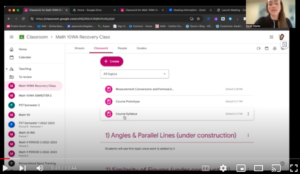As I write my final blog post tonight, a quote from an old professor comes to my mind:
“Start small, start smart, but at least start.” – Nick Forsberg
Well Nick, I will tell you that I DID NOT start small on this project. I should start by saying I had good intentions on developing multiple online courses for all the disciplines I teach (Math 9, Math 10WA and PE). If you know me, you know that I like to jump in with both feet. I tend to have big ideas and (sometimes) an unrealistic timeline for myself. What I didn’t know was that building an online course takes time, patience, and many hours of planning. Even though I am handing in my course prototype tonight with 5 out of 7 modules “under construction,” I still have plans on finishing these before I return to work next year.
An Overview of My Course Prototype
Every year when I teach Math 10WA, I have students fail the course because they are unable to keep up with classroom content, or have been removed from class as a result of violating the school’s attendance policy, or students have quit coming to class due to personal reasons. I believe students who have failed this course should be given another opportunity to try again; whether that is enrolling in another face-to-face Math 10WA class with a teacher, or completing the required modules online (asynchronously). This class serves as an opportunity for students to “try again” and work with a Student Support Teacher (SST) to attain a Math 10 credit while meeting their personal needs (for example: learning in a different environment).
After countless hours of planning my course, creating content, editing videos, and organizing my materials, I am very excited to share my final course prototype with everyone! This link includes my course profile detailing the purpose, target audience, learning objectives, lesson plans, and more.
An Overview of the Creating Process
If I had a superpower, I would be perfect every minute of the day and wouldn’t need to re-do anything. In reality, I am far from perfect; however, I expect perfection in the work I produce. Creating this online course generated some frustration for me as I would change my plans often, and re-record my instructional videos because I found a “small” mistake in them. I quickly realized that I was never going to be 100% satisfied with my work, and I needed to find balance with my time.
During our Zoom meeting with Katia on March 13th, we discussed accessibility and equity online. I reflected on my prototype and wondered if I needed to make some changes to my course. I ended up adapting many of my google documents and hyperlinks to ensure my content was accessible for all my learners. I also appreciated the week when we peer-reviewed our colleagues’ prototypes. It was refreshing to get new perspectives on my LMS, course content, and assignments. The peers who reviewed my course provided excellent feedback for me to consider, which inspired me to make some positive changes to my prototype.
Overall, I am proud of the work I have done to complete my Math 10WA Recovery Credit Course, and I am excited to try it next year with my students! I am sure I will modify assignments/activities in the future to continue improving my course.
Video Walkthrough
Here is a link to my course walkthrough so you can see how it is set up!
I hope you enjoy 


